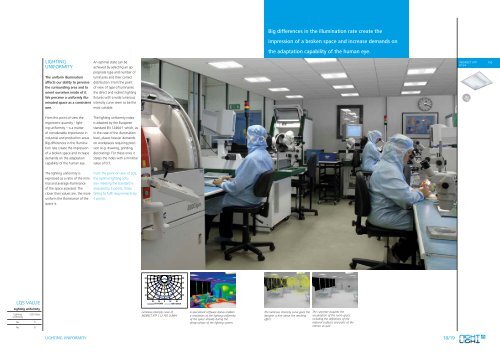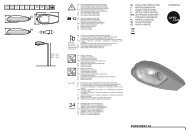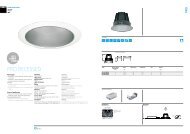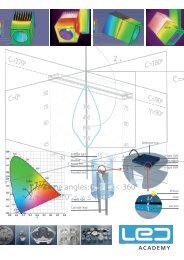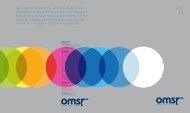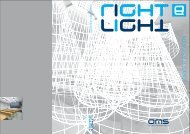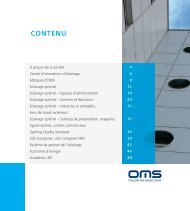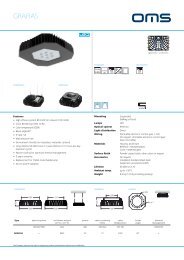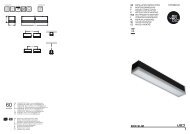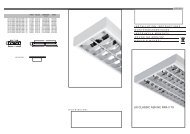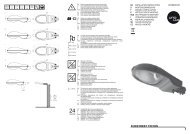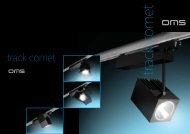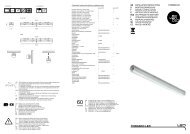Download PDF Catalogue - OMS lighting
Download PDF Catalogue - OMS lighting
Download PDF Catalogue - OMS lighting
You also want an ePaper? Increase the reach of your titles
YUMPU automatically turns print PDFs into web optimized ePapers that Google loves.
Big differences in the illumination rate create the<br />
impression of a broken space and increase demands on<br />
the adaptation capability of the human eye.<br />
LIGHTING<br />
UNIFORMITY<br />
The uniform illumination<br />
affects our ability to perceive<br />
the surrounding area and to<br />
orient ourselves inside of it.<br />
We perceive a uniformly illuminated<br />
space as a consistent<br />
one.<br />
An optimal state can be<br />
achieved by selecting an appropriate<br />
type and number of<br />
luminaires and their correct<br />
distribution. From the point<br />
of view of type of luminaires<br />
the direct and indirect <strong>lighting</strong><br />
fixtures with a wide luminous<br />
intensity curve seem to be the<br />
most suitable.<br />
indirect XTp 150<br />
ip 54<br />
From this point of view the<br />
ergonomic quantity - <strong>lighting</strong><br />
uniformity – is a matter<br />
of considerable importance in<br />
industrial and production areas.<br />
Big differences in the illumination<br />
rate create the impression<br />
of a broken space and increase<br />
demands on the adaptation<br />
capability of the human eye.<br />
The <strong>lighting</strong> uniformity index<br />
is adapted by the European<br />
standard EN 12464-1 which, as<br />
in the case of the illumination<br />
level, places heavier demands<br />
on workplaces requiring precision<br />
(e.g. drawing, grinding,<br />
decorating). For these ones it<br />
states the index with a minimal<br />
value of 0.7.<br />
The <strong>lighting</strong> uniformity is<br />
expressed as a ratio of the minimal<br />
and average illuminance<br />
of the space assessed. The<br />
closer their values are, the more<br />
uniform the illuminance of the<br />
space is.<br />
From the point of view of LQS,<br />
the optimal <strong>lighting</strong> solution<br />
meeting the standard is<br />
assessed by 5 points, those<br />
failing to fulfil requirements by<br />
0 points.<br />
90<br />
90<br />
LQS VALUE<br />
75<br />
75<br />
100<br />
60<br />
150<br />
60<br />
200<br />
45<br />
250<br />
45<br />
cd/klm<br />
30 15 0 15 30<br />
C0.0-C180.0 C90.0-C270.0<br />
Lighting uniformity<br />
Lighting<br />
uniformity<br />
LQS Value<br />
Yes 5<br />
No 0<br />
Luminous intensity curve of<br />
INDIRECT XTP C L2 FSD 2x36W<br />
A specialised software dialux enables<br />
a simulation of the <strong>lighting</strong> uniformity<br />
of the space already during the<br />
design phase of the <strong>lighting</strong> system.<br />
The luminous intensity curve gives the<br />
designer a hint about the resulting<br />
effect.<br />
The customer acquires the<br />
visualisation of the room space<br />
including the definitions of the<br />
material surfaces and parts of the<br />
interior as well.<br />
Lighting uniformity<br />
18/19


